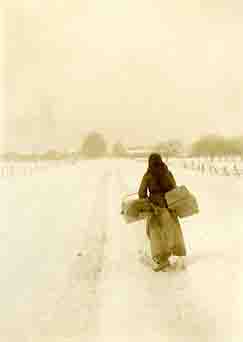industrialization & immigration
Jewish Immigrants in Springfield
Like most European immigrants during the mid-1800s, Jews typically arrived in New York before seeking their place in an American society being transformed by industrialization and commercial expansion.
The Eastern European Jews, displaced by the late-century pogroms, were generally poorer than the earlier wave of German Jews, and many were forced to work in "sweat shops" in New York City's garment district. Others more fortunate made their way north toward Hartford and in the late 1870s and early 1880s began to arrive in Springfield and Holyoke. Many followed in the footsteps of their predecessors, literally, obtaining peddler's supplies on consignment from their German counterparts and wandering the countryside hawking their wares.
The increasing prosperity of Jewish immigrants led to the establishment of settled communities and expanded opportunities for succeeding generations. During the 1880s, the Jewish community in Springfield's North End expanded from its center along Liberty Street to the Irish neighborhoods on Ferry and Sharon streets. Community leaders, including Louis Lasker and Moses Glickman, began as peddlers, but their sons and grandsons became grocers, furniture makers, tailors, educators, lawyers, aldermen and doctors.
The first Jewish religious society in the city was formally established in November 1887 in a single upper story room of the Patton Building on the corner of Main and Hampden streets. The Jewish synagogue secured a second room along Main Street, and in June 1892 the congregation was incorporated and named Beth Israel, or House of Israel.
Having established a new neighborhood with a distinct flavor in a city populated by numerous immigrant groups, the Jews began branching out into other parts of the city. Parcels along Chestnut, Dwight and North streets were annexed to the Ferry-Sharon-Liberty Street neighborhood. Successful Jewish merchants established businesses along Main Street and began to invest in properties around town, and families with means began to move to the newer, less-crowded Forest Park section of the city.
As the number of Jewish immigrants grew, so too did the level of animosity directed towards them, specifically from a neighboring community of Syrian immigrants. As a result of anti-Semitic taunts, street fights often erupted between Jews and Syrians. 1 One Jewish Springfield resident recalled: "If there was any trouble between the Syrians and the Jews, the Gordenstein boys came to the front. If there was fighting to be done. those fellas were in their fighting. they held their own." 2 In addition to neighborhood protectors like the Gordenstein boys, and unlike the laws in European countries during this period, the American judicial system offered Jews protection from persecution.
Jews in the U.S. still faced much bigotry, despite gains in the professions and the development of vibrant communities. Solidarity in the face of adversity led to the creation of new agencies and organizations offering assistance for European Jews displaced by World War I. Jewish groups lobbied against immigration restrictions and the introduction of religious education in public schools. A wave of xenophobia following the war led to "Red Raids" targeting Jewish fraternal organizations meeting at Liberty Hall on North Street in January 1920.
Conservative and Orthodox synagogues were established during the 1920s and 1930s. The Young Men's Hebrew Association provided social and recreational programs in a building on Sargent Street before joining with other community organizations to purchase a new building near Forest Park to house the newly created Jewish Community Center.
Education within the Jewish community had long been the purview of synagogues, small Yiddish and Hebrew schools, and private Hebrew instructors. In 1915, community leaders organized the Springfield Hebrew School on Tenth Street to provide free education for Jewish youths. In 1939 the Springfield Hebrew Institute on Massasoit Street opened, eventually serving some 150 students annually through the 1940s. The Hebrew Institute relocated to 557 Chestnut Street in 1951, but enrollment declined with the migration of Jews to the Forest Park area.
Most Jewish immigrants eagerly adopted American customs, but through their religious traditions and local organizations they also maintained their European heritage, which enriched the Springfield community and continues to shape the area today.
2 Gelin, 82.
